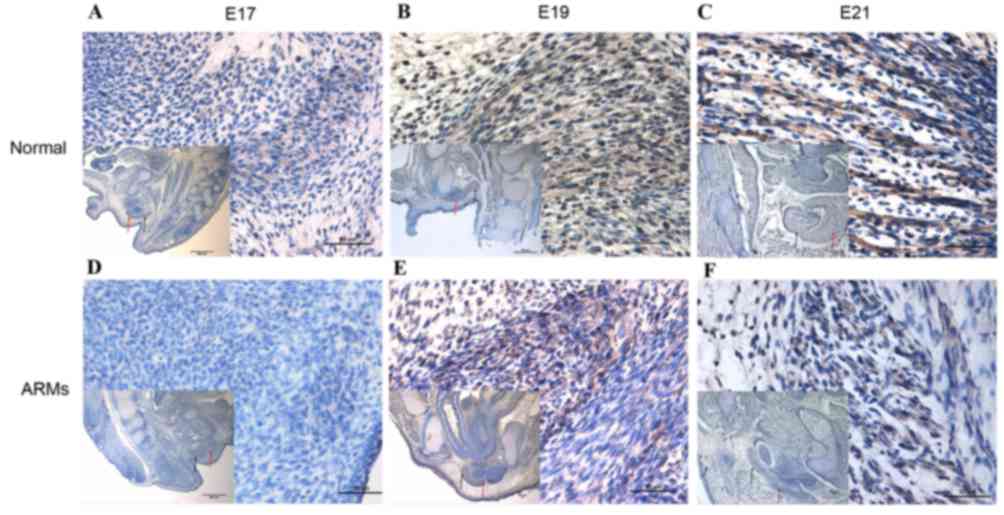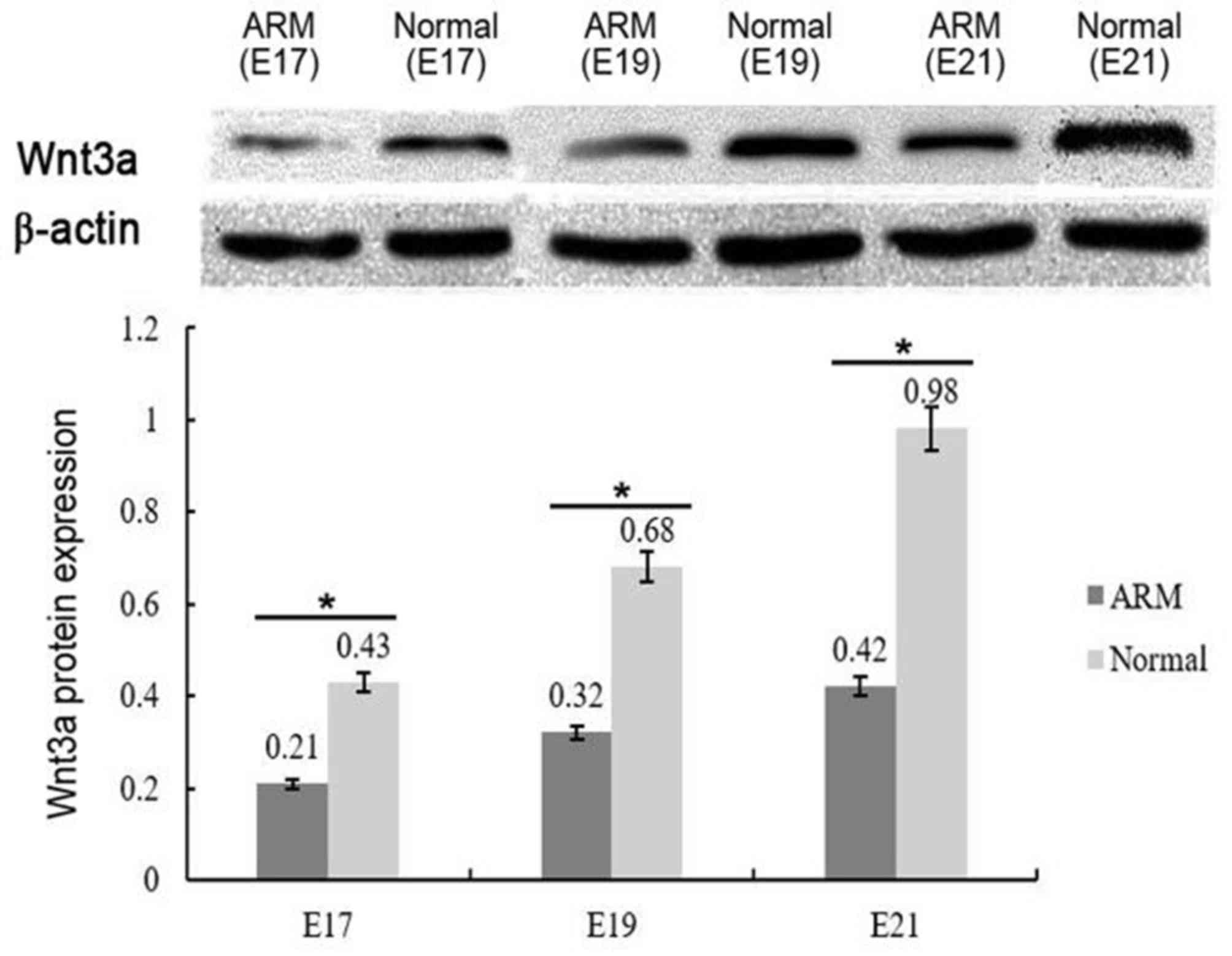|
1
|
Peña A, Guardino K, Tovilla JM, Levitt MA,
Rodriguez G and Torres R: Bowel management for fecal incontinence
in patients with anorectal malformations. J Pediatr Surg.
33:133–137. 1998. View Article : Google Scholar : PubMed/NCBI
|
|
2
|
Levitt MA and Peña A: Outcomes from the
correction of anorectal malformations. Curr Opin Pediatr.
17:394–401. 2005. View Article : Google Scholar : PubMed/NCBI
|
|
3
|
Sonnino RE, Reinberg O, Bensoussan AL,
Laberge JM and Blanchard H: Gracilis muscle transposition for anal
incontinence in children: Long-term follow-up. J Pediatr Surg.
26:1219–1223. 1991. View Article : Google Scholar : PubMed/NCBI
|
|
4
|
Bai Y, Yuan Z and Wang W, Zhao Y, Wang H
and Wang W: Quality of life for children with fecal incontinence
after surgically corrected anorectal malformation. J Pediatr Surg.
35:462–464. 2000. View Article : Google Scholar : PubMed/NCBI
|
|
5
|
Rintala RJ and Lindahl H: Is normal bowel
function possible after repair of intermediate and high anorectal
malformations? J Pediatr Surg. 30:491–494. 1995. View Article : Google Scholar : PubMed/NCBI
|
|
6
|
Rintala R: Postoperative internal
sphincter function in anorectal malformation: A manometric study.
Pediatr Surg Int. 5:127–130. 1990. View Article : Google Scholar
|
|
7
|
Li L, Li Z, Wang LY and Xiao FD: Anorectal
anomaly: Neuropathological changes in the sacral spinal cord. J
Pediatr Surg. 28:880–885. 1993. View Article : Google Scholar : PubMed/NCBI
|
|
8
|
Yuan Z, Bai Y, Zhang Z, Ji S, Li Z and
Wang W: Neural electrophysiological studies on the external anal
sphincter in children with anorectal malformation. J Pediatr Surg.
35:1052–1057. 2000. View Article : Google Scholar : PubMed/NCBI
|
|
9
|
Fernández-Fraga X, Azpiroz F and
Malagelada JR: Significance of pelvic floor muscles in anal
incontinence. Gastroenterology. 123:1441–1450. 2002. View Article : Google Scholar : PubMed/NCBI
|
|
10
|
Yuan ZW, Lui VC and Tam PK: Deficient
motor innervation of the sphincter mechanism in fetal rats with
anorectal malformation: A quantitative study by fluorogold
retrograde tracing. J Pediatr Surg. 38:1383–1388. 2003. View Article : Google Scholar : PubMed/NCBI
|
|
11
|
Jia H, Zhang K, Zhang S, Yuan Z, Bai Y and
Wang W: Quantitative analysis of sacral parasympathetic nucleus
innervating the rectum in rats with anorectal malformation. J
Pediatr Surg. 42:1544–1548. 2007. View Article : Google Scholar : PubMed/NCBI
|
|
12
|
Chen QJ, Jia HM, Zhang SW, Bai YZ, Yuan ZW
and Wang WL: Apoptosis during the development of pelvic floor
muscle in anorectal malformation rats. J Pediatr Surg.
44:1884–1891. 2009. View Article : Google Scholar : PubMed/NCBI
|
|
13
|
Mi J, Chen D, Ren X, Jia H, Gao H and Wang
W: Spatiotemporal expression of Wnt5a during the development of the
striated muscle complex in rats with anorectal malformations. Int J
Clin Exp Pathol. 7:1997–2005. 2014.PubMed/NCBI
|
|
14
|
Pansters NA, Velden JL vander, Kelders MC,
Laeremans H, Schols AM and Langen RC: Segregation of myoblast
fusion and muscle-specific gene expression by distinct
ligand-dependent inactivation of GSK-3β. Cell Mol Life Sci.
68:523–535. 2011. View Article : Google Scholar : PubMed/NCBI
|
|
15
|
Tanaka S, Terada K and Nohno T: Canonical
Wnt signaling is involved in switching from cell proliferation to
myogenic differentiation of mouse myoblast cells. J Mol Signal.
6:12–28. 2011. View Article : Google Scholar : PubMed/NCBI
|
|
16
|
Zhuang L, Hulin JA, Gromova A, Nguyen TD
Tran, Yu RT, Liddle C, Downes M, Evans RM, Makarenkova HP and Meech
R: Barx2 and Pax7 have antagonistic functions in regulation of Wnt
signaling and satellite cell differentiation. Stem Cells.
32:1661–1673. 2014. View Article : Google Scholar : PubMed/NCBI
|
|
17
|
Ren X, Mi J, Jia H, Gao H, Bai Y and Wang
W: Reduced Wnt3a expression correlates with poor development of the
hindgut in rats with anorectal malformations. Exp Mol Pathol.
99:81–85. 2015. View Article : Google Scholar : PubMed/NCBI
|
|
18
|
Pluznick JL, Wei P, Grimm PR and Sansom
SC: BK-{beta1} subunit: Immunolocalization in the mammalian
connecting tubule and its role in the kaliuretic response to volume
expansion. Am J Physiol Renal Physiol. 288:846–854. 2005.
View Article : Google Scholar
|
|
19
|
Mandhan P, Quan QB, Beasley S and Sullivan
M: Sonic hedgehog, BMP4 and Hox genes in the development of
anorectal malformations in ethylenethiourea-exposed fetal rats. J
Pediatr Surg. 41:2041–2045. 2006. View Article : Google Scholar : PubMed/NCBI
|
|
20
|
Livak KJ and Schmittgen TD: Analysis of
relative gene expression data using real-time quantitative PCR and
the 2(−Delta Delta C(T)) Method. Methods. 25:402–408. 2001.
View Article : Google Scholar : PubMed/NCBI
|
|
21
|
Adhihetty PJ, O'Leary MF, Chabi B, Wicks
KL and Hood DA: Effect of denervation on mitochondrially mediated
apoptosis in skeletal muscle. J Appl Physiol (1985). 102:1143–1151.
2007. View Article : Google Scholar : PubMed/NCBI
|
|
22
|
Katoh M: Dysregulation of stem cell
signaling network due to germline mutation, SNP, Helicobacter
pylori infection, epigenetic change and genetic alteration in
gastric cancer. Cancer Biol Ther. 6:832–839. 2007. View Article : Google Scholar : PubMed/NCBI
|
|
23
|
Katoh M: Cancer genomics and genetics of
FGFR2 (Review). Int J Oncol. 33:233–237. 2008.PubMed/NCBI
|
|
24
|
Katoh Y and Katoh M: Hedgehog signaling,
epithelial-to-mesenchymal transition and miRNA (review). Int J Mol
Med. 22:271–275. 2008.PubMed/NCBI
|
|
25
|
Garciadiego-Cazares D, Rosales C, Katoh M
and Chimal-Monroy J: Coordination of chondrocyte differentiation
and joint formation by alpha5beta1 integrin in the developing
appendicular skeleton. Development. 131:4735–4742. 2004. View Article : Google Scholar : PubMed/NCBI
|
|
26
|
Katoh M: WNT signaling in stem cell
biology and regenerative medicine. Curr Drug Targets. 9:565–570.
2008. View Article : Google Scholar : PubMed/NCBI
|
|
27
|
Bailey J, Singh PK and Hollingsworth MA:
Cancer metastasis facilitated by developmental pathways: Sonic
hedgehog, Notch, and bone morphogenetic proteins. J Cell Biochem.
102:829–839. 2007. View Article : Google Scholar : PubMed/NCBI
|
|
28
|
Tajbakhsh S, Borello U, Vivarelli E, Kelly
R, Papkoff J, Duprez D, Buckingham M and Cossu G: Differential
activation of Myf5 and MyoD by different Wnts in explants of mouse
paraxial mesoderm and the later activation of myogenesis in the
absence of Myf5. Development. 125:4155–4162. 1998.PubMed/NCBI
|
|
29
|
Takata H, Terada K, Oka H, Sunada Y,
Moriguchi T and Nohno T: Involvement of Wnt4 signaling during
myogenic proliferation and differentiation of skeletal muscle. Dev
Dyn. 236:2800–2807. 2007. View Article : Google Scholar : PubMed/NCBI
|
|
30
|
Tsivitse S: Notch and Wnt signaling,
physiological stimuli and postnatal myogenesis. Int J Biol Sci.
6:268–281. 2010. View Article : Google Scholar : PubMed/NCBI
|
|
31
|
Zhang SW, Bai YZ, Zhang SC, Wang DJ, Zhang
T, Zhang D and Wang WL: Embryonic development of the striated
muscle complex in rats with anorectal malformations. J Pediatr
Surg. 43:1452–1458. 2008. View Article : Google Scholar : PubMed/NCBI
|
|
32
|
Bourdelat D and Barbet JP: Morphological
differentiation of the anorectal sphincter in the human embryo and
fetus. Chir Pediatr. 31:12–17. 1990.(In French). PubMed/NCBI
|











